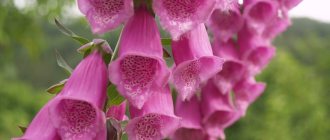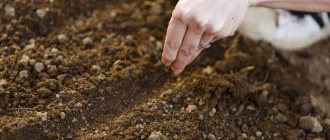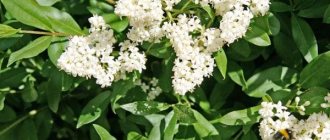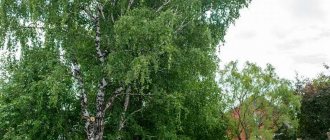Description of the plant
The crown of the plant consists of erect shoots, smooth or pubescent.
The leaves are opposite, simple, with jagged or serrated edges.
The bark is usually not rough, only in old plants it flakes off and can acquire a hard structure.
The shoots are hollow inside already from the second year of the bush’s life.
The root system usually consists of several central powerful rods and numerous short fibrous roots located in the upper half of the root. This structure makes it drought-resistant and easy to replant.
The flowers of many varieties of the plant are bell-shaped
The flowers are simple or double of 5 petals, collected in spherical large apical inflorescences of white or all shades of pink, red, purple. The plant does not have a pronounced aroma. The fruit is a small spherical capsule with seeds inside.
In nature, shrubs can be compact and grow up to 40 cm, but most often an adult plant reaches 150–200 cm. Some individuals become real giants up to 4 m high. The average life expectancy is 20–25 years.
Varieties of deutia from Japan and the Himalayas were brought to Europe in the mid-19th century, and at the end of the century, Chinese species of shrubs appeared in the gardens and estates of gardeners from the Old World.
The origin of the name, according to some theories, is associated with the name of a merchant from the Netherlands and mayor of Amsterdam, Johann van Deitz. In the 18th century, he financed an expedition of Dutch scientists to Japan, where they first encountered this species. The plant was named in honor of the philanthropist by botanist Carl Peter Thunberg, but people often call Deutia an Asian or Oriental beauty.
Transfer
The procedure is performed while the bush is young and the root system has not grown very much. Adult plants are also replanted, but you will have to act very carefully: carefully and deeply pry up the underground part, having previously dug up the plant along the perimeter of the crown projection. You can’t rush: it’s important to preserve the earthen lump and damage as few fibrous roots as possible.
Deutzia is replanted only in the spring: it takes until autumn for the shrub to take root well in the new area. Effective and safe biostimulants reduce the level of stress during transplantation: Epin, Fitosporin, Zircon. Use the products according to the instructions: before or after transplantation, in the optimal concentration.
Landing
The plant cannot be called unpretentious: it does not like waterlogging and is afraid of cold winds and low temperatures. Among the positive agrotechnical characteristics one can highlight drought resistance.

It is best to plant shrubs in open ground in spring.
Planting is best done in the spring, after the final retreat of night frosts, when the buds on the trees have not yet opened.
Choosing a landing site
The plant will feel best on the southwestern slopes, which are quite gentle, which are covered with a dense layer of snow in cold winters. It is better to choose a site for planting that is shaded, without direct sunlight, and protected from wind and drafts. Groundwater should lie no higher than at a depth of 2.5–3 meters.
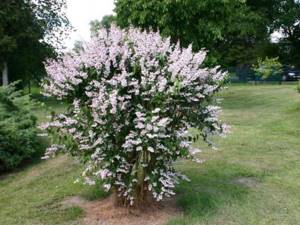
The shrub must be planted at a considerable distance from other plants and buildings
Loose, fertile soil, with a mandatory drainage layer, is ideal for an oriental beauty. You can make neutral or slightly acidic soil with these characteristics yourself by mixing two parts of compost soil and humus with one part of sand.
How to plant correctly
Shrubs should be planted individually, at a distance of at least 2 meters from each other, other plants, buildings and obstacles. The depth of the planting hole is quite large - at least 50 cm in depth and the same in width and length.
At the bottom of the hole you need to pour drainage (sand, broken brick, expanded clay), 250 gr. lime or wood ash. If homemade soil is used, then the size of the hole needs to be increased by 30–40 cm.
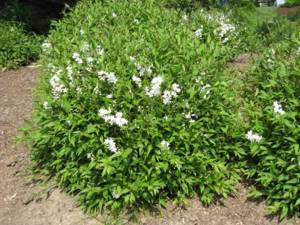
The plant takes root well in open ground in central Russia
Before planting, seedlings with an open root system are placed in a solution of Kornevin or any other drug to stimulate root growth. The roots are straightened directly on site. If you plant a plant with a lump of earth, then its lower part needs to be broken up a little and the roots straightened.
Seedlings without a clod of earth should be transported to the planting site by wrapping the lower part with thick paper or newspapers.
After the trunk is buried, the root collar of the bush should protrude above the ground or be at a depth of a maximum of 1–2 cm below the ground level. After planting, the soil should be watered with a bucket of water and compacted; the tree trunk circle should be mulched with a layer of peat of 5–7 cm.
How to choose a good seedling
When choosing between purchased seedlings in containers or with an open root system, preference should be given to the latter, since they can easily be used to assess the condition of the plant.
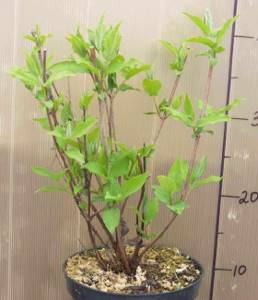
When purchasing container seedlings, it is difficult to assess the condition of the root system
Another argument in favor of the solution is the lower cost of such planting material compared to container specimens. Before planting, shrubs are pruned from dried shoots and the roots are shortened to 40 cm.
If, after purchasing a young bush, it turns out that its roots are too dry, the plant can be revived by immersing it in a mixture of clay, water and mullein with the addition of a weak solution of manganese for 2–3 hours.
Planting and propagation
Deutzia is planted in early spring; the hole for the plant must be prepared in accordance with the selected type of shrub; however, there are general conditions:
- open or slightly shaded area;
- the depth of the hole is from 30 to 60 cm; after planting, the root neck of the bush should be open;
- to stimulate the plant adaptation process, liquid manure is added at the rate of 4-5 liters per bush;
- if a composition or a hedge is being made, then the distance between small actions should be from one and a half to two meters.
The plant propagates by both seeds and cuttings. Seeds are usually germinated. Then the plants are grown in boxes for up to a year, and only after that they are planted in the garden. However, self-seeding occurs quite often, especially in abandoned garden plots, and bushes that grow independently are no less decorative or resilient. Than those who grew up “by the rules.” Such bushes bloom for the first time in the third year of life.
Cuttings for propagation are cut in the spring; their length should be from 10 to 15 cm. For faster rooting, the cut is treated with modern means to stimulate the formation of the root system. The cutting can be either immediately planted in the ground or pre-rooted in a peat tub, planting it in a permanent place at the end of summer.

For planting, you can purchase deutia seedlings, or you can buy seeds
Care
All actions aimed at stimulating the growth of Asian shrubs - watering and fertilizing - are carried out during the flowering period of the plant, which lasts on average 30–60 days. Pruning and wrapping are considered to prepare the plant for winter.
Watering
Overmoistening has a detrimental effect on the condition of the bush, so it is recommended to water it moderately: no more than 10–12 liters of water per bush every 2–3 weeks in the warm season. During periods of active growth and dry weather, watering can be increased.
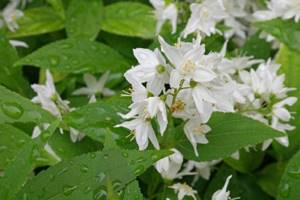
Watering the plant is stopped in August to allow the wood to ripen.
Already in the second half of August, they stop watering the plant so that the wood ripens by the beginning of cold weather. In autumn, the tree trunk area is covered with waterproof material.
It is recommended to loosen the soil under the bush after each watering, but only on the surface, so as not to touch the root system. Weeds should also be removed, ensuring oxygen access to the upper root layers of the soil.
Top dressing
Fertilizer is applied monthly during the flowering period: liquid organic matter (no more than 3–4 liters) is the best choice. At least twice a season before the end of flowering, the plant is fed by adding 130–150 grams to the soil. complex fertilizers consisting of a mixture of nitrogen, phosphate and potassium, or superphosphate.

You need to feed the bush several times a season.
Mulching the tree trunk circle with humus at the rate of 4-5 liters per bush will have a beneficial effect on the growth of the action and its attractive appearance. In autumn, fertilizing shrubs can only cause harm, because it leads to a decrease in winter hardiness.
Trimming

Trim shrubs with a sharp knife, pruning shears or blade
The first pruning of shoots that have died in winter during the season is carried out in May–early June. After flowering ends, the plant is pruned to rejuvenate and form the crown - and it can be given any shape.
After flowering, each branch is pruned to a young shoot and another quarter of the length for proper bud formation and increased bushiness.
Several shoots from old bushes can be removed to ground level every 2–3 years. Young shrubs 5 years old can also be pruned heavily, leaving a stump of 10–15 cm with two side shoots. But more often than not, the bush is simply given a rounded shape by shortening the branches that stand out from the total mass.
Transfer
Deutzia can only be replanted in the spring, otherwise the plant will not have time to get stronger before the cold weather. The plant should be dug according to the diameter of the projection of its crown, trying to keep the earthen lump undestroyed.
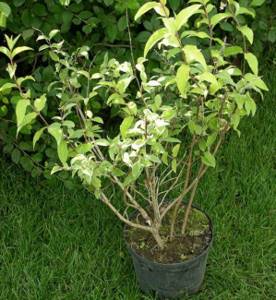
Young shrubs tolerate replanting well
The new planting hole should have a drainage layer and complex mineral fertilizing (no more than 25–30 g). You need to fill the shrub with the same mixture as when planting, then water it well, compact the soil under the plant and mulch with peat.
When replanting, it is convenient to trim dried shoots, shortening the branches by one third . A young plant can easily tolerate a change in its “place of residence”; an adult shrub can get sick.
Preparing for winter
For the winter, the plant is insulated twice: the first time - after the onset of the first night frosts. You need to press the shoots to the ground and make a small wooden frame, the surface of which is covered with fallen leaves - this is an air-dry shelter.

Air-dry cover of the shrub will preserve the viability of the plant in winter
The second stage of preparation for wintering is carried out when the average daily air temperature drops below zero. To protect the shrub from freezing, the lower massive branches of pine needles are placed on its base: this way the hollow shoots will not break from the snow masses.
You can additionally cover the shrub with non-woven fibrous material or film, which will help prevent branches from breaking under the weight of snow and prevent the soil from rotting in the spring.
It will not be possible to bend adult plants to the soil, they will simply break, so to cover old bushes you need to proceed as follows:
- Carefully collect all the shoots into one sheaf and tie it with soft rope.
- Place a lutrasil or spunbond bag on top with the closed bottom facing up.
- Secure the material from below with clothespins and tie it along the diameter with a soft tourniquet.
If the plant is not protected from the cold in time, it will not bloom next spring.
It is recommended to remove the shelter in early spring, when the snow has melted, at positive average daily temperatures. You need to free the plant without waiting for the remaining leaves to begin to rot. Also, the bushes should not be allowed to get wet.
If you do not get rid of the shelter in time (usually in early April), this will slow down the process of spring vegetation of the shrub.
Outdoor care
The activities are simple, the action requires less attention than the capricious Azalea or the beautiful Wisteria. The following describes the features of the basic argotechnical procedures.
Watering
Add water to the soil from spring until the end of August. Creating a layer of mulch is an event thanks to which an amateur gardener forgets about the problem of soil drying out.
In the absence of heat, water the bush once every two weeks, with about a bucket of water. In July, the amount of liquid is increased to two buckets at a time; in very hot times, the deutsion is watered every week. It is useful to loosen the soil (up to 15 cm), removing weeds as you go. The mulch is periodically updated.
Feeding and fertilizer
Regular application of organic nutrients is carried out throughout flowering: it is useful to add 3 liters of diluted manure per plant. Fertilizing is done on a cool day, in the morning or evening.
Twice a season, be sure to fertilize the soil with complex mineral mixtures with potassium, phosphorus, nitrogen, magnesium and other ingredients. For each bush, 120 g of granules is enough. Before fertilizing, water the plants well.
Care during and after flowering
It is useful to remove wilted inflorescences in time, monitor whether harmful insects have appeared, and begin the fight against aphids and other parasites in time. Watering is moderate, regular, and be sure to fertilize. Mulching and loosening are agrotechnical measures that have a positive effect on the condition of the substrate and the plant.
Deutia blooms begin in early June; inflorescences and single buds delight the eye almost until the end of July. Next, carefully cut off all the faded branches so that new, young shoots are more actively formed at the base of the crown.
Bush formation
Pruning is an event that is approached selectively:
- If the deutzia bushes poorly, then you need to trim the ornamental plant more often. First, old shoots are removed, feeding them a lot of juices, but growth is still weak.
- The shrub is easily propagated by layering: long branches are bent to the ground, rooted, and the cuttings are transplanted to a new area. You should not prune unless absolutely necessary, otherwise there will be fewer layerings suitable for vegetative propagation.
- Even with good care, a small number of broken, weak or damaged shoots appear on the plant during the season. It is advisable to get rid of problematic elements as soon as possible.
- Thinning of branches and pruning of side shoots is carried out in deutia hedges if, during planting, neighboring shrubs were planted at a smaller interval than required. Thickened plantings mean not only a decrease in decorativeness due to bending branches, but also poor air circulation.
- Do not cut the plant unnecessarily: the flowering power decreases.
- Starting from the third year of the plant’s life, after the buds have withered, all faded shoots are removed from the bush, and the remaining branches are well cared for.
- Sanitary pruning is carried out in March: all frozen and damaged shoots are removed.
- When rejuvenating pruning, all branches are shortened and a stump is left. The same procedure is needed if most of the shoots are frozen in winter.
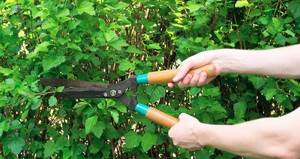
Reproduction
Deutia is quite easy to grow from seeds, but other methods of propagation: cuttings, division, planting root shoots and layering are just as effective.
Seminal

A shrub grown from seeds blooms in the third year of life.
Seed propagation does not require any other preparation other than loosening the soil at the intended planting site. Seeds are harvested in the fall from ripened fruits, and in the spring they are sown on the surface of the soil, without sprinkling with anything. It is important that the beds are located in a shady place and that the seedlings receive sufficient watering.
Seed germination persists for 1–3 years; they need to be stored in a cool place in sealed bags or tightly closed containers.
Under favorable conditions, the first shoots will appear within 20–25 days. As soon as two pairs of true leaves form on the seedlings, they need to be picked. Plants obtained in this way begin to bloom in the third year of life.
Vegetative
To propagate deutia by cuttings, young shoots 15–20 cm long are cut from mid-June to mid-July, until the bark of the shoots becomes hard.
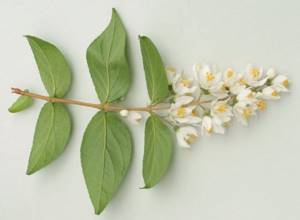
Oriental beauty cuttings for propagation should be prepared in June-July
The lower cut of the branches is dipped in a root formation stimulator, and then planted in greenhouses in the soil at an angle to a depth of 1 cm. You can achieve 100% rooting of cuttings by installing a fogger in a greenhouse covered with film. Rooted branches are transferred to open ground when shoots appear on them - such seedlings take another 1.5–2 years to grow.
You need to trim the shoot 0.5–1 cm below the node with a sharp knife or blade. Leaves from the bottom of the cutting are usually removed.
Cuttings with a lignified trunk can also be cut for subsequent propagation. This should be done in late autumn, choosing branches with 3–5 buds. In winter, they are stored, sprinkled with earth, in a cold, dark place, planted in a greenhouse in the first spring months.
Dividing the bush
New shrubs can also be obtained by dividing an old plant into 2-3 parts . Dry and too thick shoots are immediately removed.
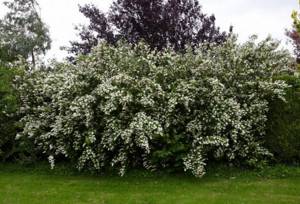
New bushes can be obtained by dividing an old plant
Division can be carried out by separating the root shoots from the adult action. Both of these methods of propagation are resorted to in the spring, so that new bushes have time to take root and grow before the cold weather.
By layering
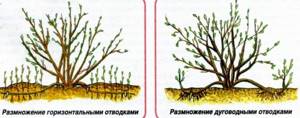
Reproduction scheme by layering
A fairly quick and hassle-free way to get a new plant. For propagation, one of the side shoots is pressed to the ground and dug in. To speed up the process, the bark at the site of the future root is slightly scratched.
After the branch takes root, next spring it is separated from the mother bush and replanted as a regular seedling.
Action care
This shrub is quite unpretentious and undemanding in care. For successful cultivation, it is enough to water it moderately, sometimes feed it, mulch and sometimes prune it. It is quite resistant to diseases and pests, so it does not require special attention.
Watering
In the absence of regular natural rainfall, it is enough to pour 1 bucket of water under the bush once a week. It is important to take into account that such a technique as mulching with a layer of up to 5 cm allows you to maintain optimal humidity under the plant, and also eliminates the need for regular loosening. In rainy weather, there is no need to water the plant additionally. If the summer turns out to be dry, watering can be increased to 2 buckets of water, depending on the composition of the soil and the size of the plant. However, in August, watering can be stopped altogether.
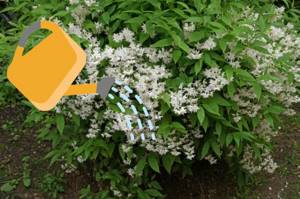
Top dressing
It is not necessary to feed the bush in the first three years if you follow the planting rules and fill the planting hole with fertile soil. Fertilizing can be done starting from the third year of the growing season. The shrub responds to monthly fertilizing based on liquid manure at the rate of 3–4 liters for each root.

Trimming
This is an important agricultural technique when growing deutia. Pruning should be done twice a year. Sanitary pruning is carried out in early spring. It consists of removing poorly overwintered branches: dry and damaged. The second pruning is carried out in the fall. Its rules are to shorten faded branches to the first strong bud or to the base of the shoot. Then it is necessary to evaluate the general appearance of the crown and carry out shaping pruning, giving the bush the desired shape. It is periodically necessary to rejuvenate the bush by removing old branches to the base.
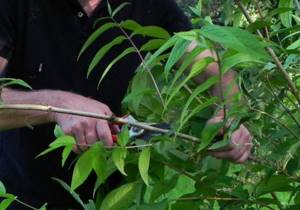
Preparing for winter
In October - November (depending on weather conditions), as for every plant, it is worth taking care of moisture-replenishing watering for a successful wintering of the bush. Young plants must be covered for the winter. The shoots are quite easily bent to the ground and covered. Spruce branches, dry leaves, etc. are well suited for these purposes. The top can be covered with burlap or other covering material.
Did you know? The smallest shrubs on the planet are dwarf willows, they are only 5 cm tall and grow under moss. Their habitat is North America. They can be seen occasionally - microscopic leaves and sometimes flowers appear above the moss.
It will not be possible to bend down the adult branches of the plant, as they can easily break. As a rule, they are tied together and a non-woven covering material, burlap, etc. is put on top. If some branches cannot be protected from freezing, do not be upset. They will just need to be trimmed in the spring. The bush has good regenerating properties; it will simply replace the branches with new ones. The only drawback is that they will not bloom this year.
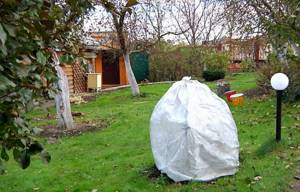
Diseases and pests
As mentioned above, deutzia is not susceptible to pests and diseases. Occasionally, it is attacked by the bumblebee proboscis, which damages the leaves. It is easy to get rid of it by treating it with Karbofos or other insecticides suitable for this purpose.
Pests and diseases
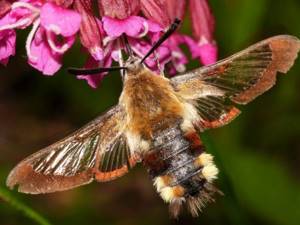
The bumblebee butterfly is the main pest of the Asian beauty
Deytsia is quite resistant to pests and diseases. One of the main parasitic insects that damages the plant and feeds on its leaves is the bumblebee proboscis butterfly. You can get rid of it by spraying the bush with a 15% solution of Phtalofos or Karbofos.
Mites, aphids, and caterpillars with a horn and two stripes on a bright green body, which also quickly eat up the foliage, can also attack the shrub. They are combated by spraying with insecticides (preparations “Decis”, “Bitoxibacillin”, “Lepidocid-BTU”).
One must also be wary of rotting of the root system due to excessive watering; in this case, the shrub is difficult to revive.
Common varieties of deutzia shrubs
Various varieties of deutzia shrubs are cultivated. Various varieties of this plant allow you to maximize the variety of landscape design of your personal plot with minimal financial costs. Indeed, among the common varieties of deutzia shrubs, there are species that are capable of forming full-fledged hedges and garden sculptures over the course of 1-2 growing seasons.
The descriptions and photos of Deutia varieties presented below will help you choose the right cultivar for your garden.
Deutzia gracilis
Grows naturally in Northern China and in the mountainous areas of Japan. Accordingly, Deutia graceana has increased resistance to unfavorable climatic conditions. Deytsia slender is able to withstand long droughts and periods of sudden cold weather.
The Deutia graceful bush has a rounded shape, which is ideal for forming a garden sculpture. With proper care, Deutzia gracilis grows up to one and a half meters in length.
The leaves reach six centimeters in length, oblong, pointed, hairy above and smooth below. In summer the leaves are light green, and in autumn they acquire a yellowish tint.
The flowers are snow-white. Budding begins at the end of May, the flowering period lasts one month.

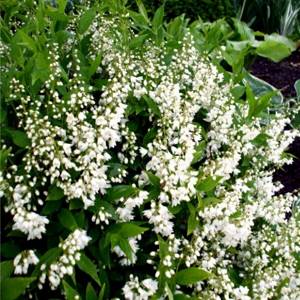
Deutzia scabra
In natural landscapes, Deutia roughens can be seen in various parts of Japan and China. This is a unique plant that has a rough surface of the leaf blade. The bush Deutzia scabra is low - up to 2.5 meters. the period of rapid flowering occurs in mid-summer. In the Moscow region this is usually the end of June or the beginning of July. The leaves are oval-shaped, 4-9 centimeters long, pale green in color. In autumn they become yellow-brown. The flowers are star-shaped, snow-white, slightly pinkish or light crimson, up to 1.5 centimeters in diameter.
The following is a photo of Deytia shershava in various vegetative stages of development:
The shrub is relatively thermophilic and does not tolerate the harsh winters of the Urals and Siberia. In these regions it is better to grow zoned varieties of Deutia shershava.

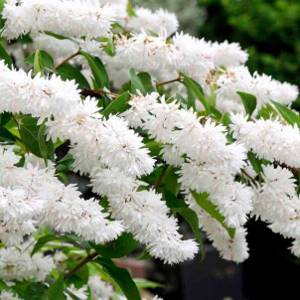
Deytsia rough is subdivided into species that are more adapted to unfavorable growing conditions:
- "Candidissima" - pure white flowers.
- "Marmorata" - distinguished by white and yellow spots on green leaves.
- "Plena" (terry deutzia) is a large shrub up to 3-4 meters in height and up to 2.5 meters in width. The flowers are double, white. The lifespan of the bush is up to 50 years. The leaves are three to eight centimeters long, oval-pointed, dark green, rough, yellow in autumn.
- "PrideofRochester" (terry deutzia) Up to 2.5-3 meters in height and up to 2.5 meters in width. The flowers are double, white.

Read also: Hydrangea paniculata planting and care in open ground pruning
Deytsia Pink Pom Pom
Deutzia Pink Pom Pom is a unique variety of this shrub, which was bred through selection at the beginning of this century. The flowers are double, white with a pinkish tint on the outer part of the petals. The leaves are dark green, rough. It has a long flowering period, which begins in early June and can continue with proper care until the end of August.
Look at the photo of the Pink Pom Pom action, which fits well into any landscape design:
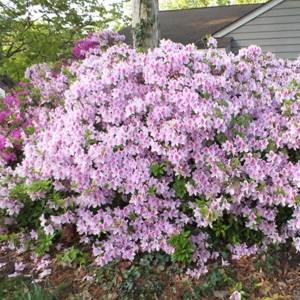
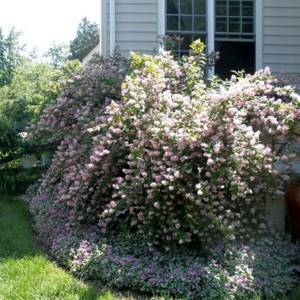
Deytsia hybrid
Obtained from crossing Deutia graceica and Deutia Amur. The hybrid deutia bush reaches a height of up to two meters. The flowers are snow-white. Gives color in the month of July. The leaves are dark green, rough to the touch, and turn yellow-red in autumn. Cold resistant.
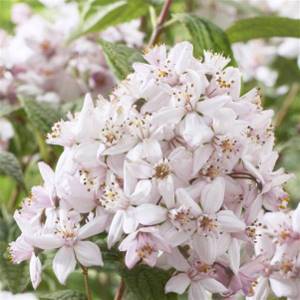
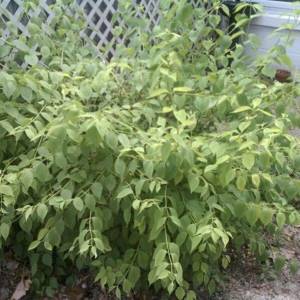
Hybrid action has the following subspecies:
- Deytsia mont rose Flowers - snow-white or pink, double. Large shrub up to 2.5 meters in height. The leaves are dark green, turning yellowish-red in autumn. Blooms from June to July. Grows well in all types of soil. Location – sun or shaded place.
- Deutzia strawberry fields Reaches 1.5 meters in height. The leaves are pointed, dark green, rough. The annual growth is about 25 centimeters. Blooms in June-July. The flowers are large in size, pink in color. Photophilous. Prefers places protected from the wind, moderately moist, fertile soils.
- Deutzia magnificent Turbilon rouge A hybrid between Deutzia rough and Deutzia Vilmorin. Reaches up to 2.5 meters in height. The leaves are oval-shaped, elongated. The flowers are snow-white, terry to the touch. Blooms in June.

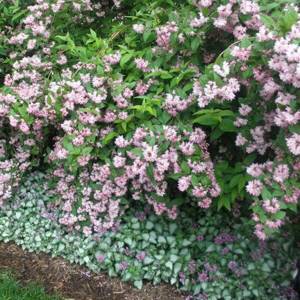
Deutzia rosea
It is a hybrid between Deutia purpurea and Deutia gracilis.
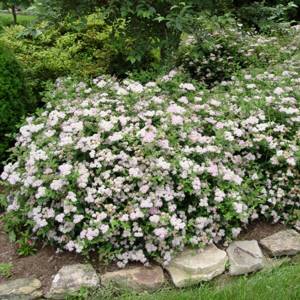
The bush grows up to one meter in length, no higher. The flowers are shaped like an open bell. The petals are pink at the bottom and a little lighter at the top.
Types and varieties
Deutia unites almost fifty, both pure and hybrid species, however, the most decorative and capable of survival are in demand in gardening and floriculture.
Graceful
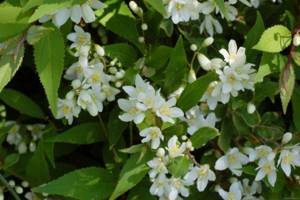
Graceful The distribution area of the species in nature is the mountainous regions of Japan. The height of the shrub varies from 45 cm to 1.5 m. It has a rounded shape, elongated serrated lanceolate leaves 6 cm long. The front surface of the leaf of this species is covered with stellate hairs, and the back is smooth, both of which have a light green, unsaturated color.
The inflorescences of the graceful action are racemose, erect, up to 10 cm long, with fifty white flowers. This species blooms in June, for a month or more. A distinctive species feature is early readiness for flowering - already in the second year after planting. Certain varieties of the bush may have a golden hue to the leaves.
The most famous variety, Nikko, can be recognized by the burgundy color of its foliage in autumn. Such shrubs bloom in May or June and look like spreading shrubs up to 85 cm tall.
Decorative forms that are widely used in gardening culture:
- golden (with yellow leaves)
- white-marbled (leaves have white spots)
Purple
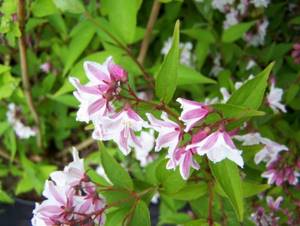
Purple Shrub up to 2 m high is named so due to the shade of flowers that appear on the plant in the form of semi-umbrella inflorescences of 15–17 pieces each.
The leaves of this species are lanceolate, wide in shape, sparsely pubescent, with a finely serrated edge. The variety will grow only in warm climates where there are no long cold winters.
Pink
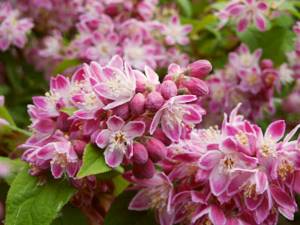
Pink A hybrid obtained from crossing the graceful and purple deutia. The flowers, taking white and purple pigment from both species, are soft pink, bell-shaped, with 30–35 flowers in each racemose inflorescence. The shrub is very compact and rarely grows higher than 1–1.2 m.
This species is perhaps the only one among other varieties of deutia that is resistant to cold winds and frosts. The most recognizable variety, Campanulata, has a dense spreading crown and bell-shaped flowers that appear in May and delight gardeners with all shades of pink.
Large-flowered
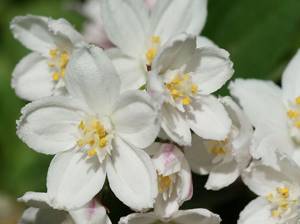
Large-flowered An early-flowering perennial, this variety of Asian shrub can reach 2 m in height and is characterized by a single arrangement of large flowers in an inflorescence.
The leaves are oval, rough on both sides, and have a dark green color. Suitable for planting in temperate and warm climates, as it does not tolerate cold weather at all.
Amur (small-flowered)
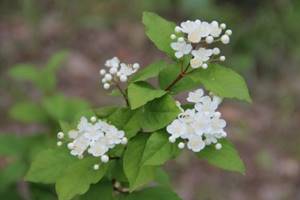
Amur (small-flowered) Spreading, deciduous shrub, common in the Far East (in some Russian nature reserves it is protected by the state), in the north of the Korean Peninsula and in China. This type of deutzia can reach 2 m, has oblong, pubescent bright green leaves up to 7 cm long.
Corymbose inflorescences with small white flowers that have no aroma reach the same size. The flowering period of this variety begins at the end of June and lasts an average of 3 weeks. The fruits are small, yellow-green, spherical with small seeds, ripen in October.
Some ornamental varieties of oriental beauty are sterile and do not bear fruit.
A distinctive feature of Amur deytsia is its resistance to dry weather, polluted air and smoke. The shrub grows very quickly and begins to bloom earlier than related species.
Rough (star-shaped)

Rough (star-shaped) This variety (natural habitat - Japan and China) has a peculiarity - brown or with shades of red bark, which peels off as the bush ages. The leaves are pale greenish in color, up to 8 cm long, and their surface is covered with star-shaped hairs that give a rough appearance (hence the name).
This type of shrub blooms later than others with beautiful long (12 cm) panicle-shaped inflorescences with pale pink or white bell-shaped flowers. The flowering period lasts 15–20 days. Rough deytsia has such forms as: terry, pink terry, white-spotted, Vaterera, pure white, and also the most interesting - Marmorata (the surface of the leaf is strewn with yellow-white spots).
The most common and popular varieties among gardeners:
- Plena (erect flowers, densely double shoots)
- Roseo Plena (double flowers in the center are snow-white, and at the edges - bright pink)
- Candissima (pinkish buds bloom into white double flowers, needs reliable shelter for the winter)
- Pride of Rochester (dense crown consisting of straight long shoots with white double flowers at the ends of the inflorescences)
- Codsell Pink (dense crown formed by curved branches, at the ends - narrow panicles-inflorescences with bright pink flowers that appear in June)
Vilmorena (colorless)
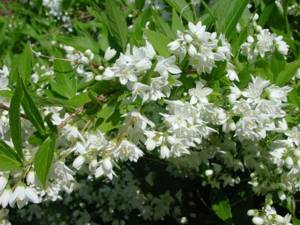
Vilmorena (colorless) The variety of Vilmorena, which is not resistant to cold, is very miniature - only 70 cm long and came to us from Central and Western China. The leaves are narrow-lanceolate with finely serrated edges, the flowers are quite small (2 cm in diameter), snow-white in color, bloom in corymbose-shaped inflorescences.
When choosing a variety of action for planting in central Russia, you should pay attention to such winter-hardy species as: Amur, graceful, Lemoine and pink. However, if the winter temperature drops below -30 degrees, no variety will survive such cold weather.
Magnificent (lush)
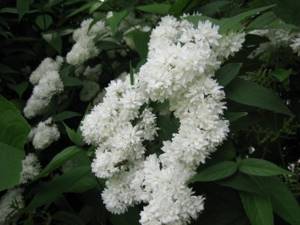
Magnificent (lush) One of the most picturesque, this hybrid of lush and Deutzia Vilmorin is an upright shrub 2–2.5 m high. The leaves are oval, long, like the inflorescences, which have an umbrella shape and a large number of white double flowers. Flowering later: begins in July and lasts 20–25 days.
The following decorative forms of this subspecies are distinguished:
- Formosa (with double flowers)
- Erecta (with dense inflorescences)
- Eburnea (drooping inflorescences)
- Superba (with bell-shaped flowers)
The most popular variety is Turbilon Rouge; in the fall the leaves change color from green to yellow-golden. The bark even on young branches is red-orange, with white stripes. It blooms in early summer with large flowers of all shades of pink. Winter hardiness is average; it needs to be covered if the winter temperature reaches -25 degrees.
Longifolia
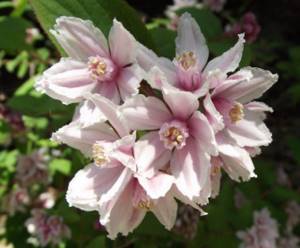
Long-leaved A characteristic feature of plants of this species is elongated leaves, 10 to 12 cm long, dark green on top and slightly grayish from the hairs below. It is rare in landscape gardening, even in botanical gardens.
The variety attracts the attention of gardeners with bright pink flowers, purple in unopened buds. Veitch's long-leaved deutzia has an even darker color during flowering, which for all representatives of the species begins at the end of July.
Lemoine
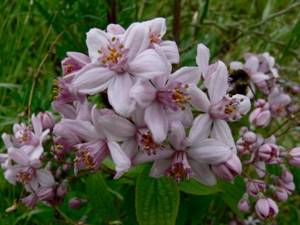
Lemoine A winter-hardy hybrid obtained from crossing small-flowered and graceful varieties, it blooms earlier than others and very abundantly. The flowers are small, white, collected in small inflorescences up to 10 cm long.
Of particular interest to gardeners are such decorative varieties of Deutia Lemoine as:
- Pink Pom Pom (flowers in hemispherical inflorescences vary from bright red to hot pink)
- Boule des Neiges (snow-white flowers of medium size up to 3 cm in diameter, the bush is quite compact - up to 1.5 m)
- Mount Rose (bright pink flowers with a special inverted petal structure)
Hybrid Strawberry Fields

Hybrid Strawberry Fields A low bush up to 150 cm with dark green rough leaves and large pink flowers with a pronounced red center, which bloom in June–July.
The shoots have an arched shape. The plant gives an annual growth of almost 30 cm. Winter hardiness is average; it needs to be well covered for the winter.
Wilson

Wilson The species of deutzia is named after the outstanding scientist and researcher of the flora of China - the Englishman Ernest Henry Wilson. A very profusely flowering natural hybrid with a flowering period of about 30 days.
The height is rarely more than 2 m, annual shoots are slightly pubescent. The bark is peeling, reddish in color. The broadly lanceolate, finely serrated leaves are green above and have a grayish tint below.
Most graceful
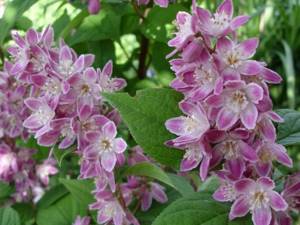
The most elegant hybrid form, obtained by crossing Deutia purpurea and Siebold, is suitable for planting only in warm climates. In mid-latitudes it can take root, but will not bloom.
The shrub reaches 150 cm, the leaves are oblong with a jagged edge. Racemose inflorescences with deep pink flowers appear at the ends of the shoots in June. Among gardeners, the Pearl Rose variety with a dense crown and lush inflorescences on the tops of the branches received special love.
Whitest

Whitest Hybrid species with large snow-white flowers up to 3 cm in diameter in large 12-cm inflorescences. In favorable conditions, a shrub of this variety can live up to 50 years and reach 2 m in height.
Smooth
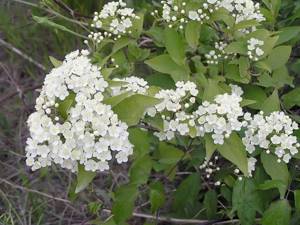
Smooth A rare protected plant, which in appearance and flowering time is very similar to the Amur variety. The main difference is the later entry into the flowering period, which for this bush occurs only in the 8th year of life.
Less common species
There are species whose resistance to diseases and pests is reduced, and winter hardiness is assessed as low. Their use in gardening and decorative floriculture is unpromising.
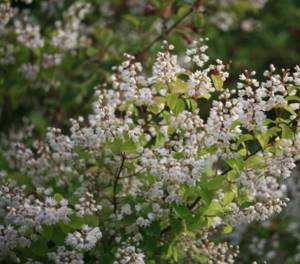
These varieties include:
- Gorodchataya. It blooms in May, the growing season lasts from April to October. The flowers are small and white
- Schneider. A low bush (up to 120 cm), which blooms with small white flowers for only 2–3 weeks in the first half of July
- Siebold
Description of the bush
The perennial shrub of the Hydrangeaceae family can be deciduous or evergreen, depending on the variety. In mid-latitudes, the plant has been used for cultivation relatively recently. In the Himalayas, East Asia and Mexico, approximately 50 species of this plant can still be found in natural conditions.
The height of the bush can reach 0.5–4 m, and its age is 25 years. The flowers, collected in small inflorescences, are white, purple, pink or lily. They are odorless and are distinguished by abundant flowering, which lasts 20 days in late spring - early summer.
Long-lasting, eye-catching flowering and ease of care, a variety of bush shapes, sizes and colors make the deutsia a favorite of gardeners and landscape design experts. The plant involuntarily creates an Asian style and introduces a note of exoticism into any, even the simplest composition.
Use in landscape design
A spreading shrub strewn with flowers will decorate any landscape composition, but the deutzia looks most impressive against the background of other flowering perennial plants and coniferous trees. The plant combines well with other flowering shrubs: mock orange, weigela, forsythia, spirea and lilac due to the combination of shades and the order of flowering periods.
Low dwarf varieties are used to create alpine slides and complex compositions of perennials - mixborders. Hybrid species of deytsia with double flowers are used to decorate alleys, paths, and walking routes.
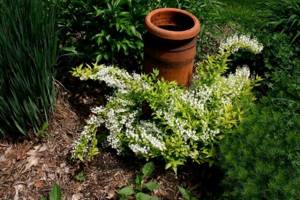
The Asian beauty looks especially picturesque against the backdrop of coniferous bushes
One of the undeniable advantages of the Asian beauty is its full development in urban conditions. Large-flowered deutia makes an excellent hedge, picturesque and resistant to smoke, so deutia is often planted in garden plots near busy highways. Deutia graceana is often used to decorate border slabs and visually lining a group of taller plants.
Despite the fact that deutia is an ornamental plant, quite susceptible to cold weather, which is not uncommon for most of the Russian Federation, you can grow this beautiful shrub on your own site. Proper planting and proper care of the oriental beauty will be rewarded with abundant beautiful flowering and an attractive appearance in the garden.
All the information on how to choose the right place to plant deutia on your site, what you need to know about watering, fertilizing and pruning the plant, how to deal with pests and diseases, is collected in the training video:
Action after flowering
Blooming deutia is a beautiful sight, pleasing to the eye for quite a long time, but eventually the flowering stops and autumn comes, which will very soon be followed by winter. Deytsia has very low cold resistance. Since deutia blooms on last year’s shoots, it is most important to protect them from frost in winter, otherwise the bush will lose its decorative effect for the entire next year. In areas characterized by snowy winters without severe frosts, it is enough to simply bend the bush to the ground.
Planting and caring for deytsia in the Moscow region or other areas with cold winters includes all the listed and described points, and nevertheless differs somewhat from caring for the plant in the southern regions, because the frosty winters of the middle zone require mandatory sheltering of the deytsia during wintering. And if your winters are frosty but snowless, you will need more serious measures to protect the shrubs from the cold than snow.
- Crocuses - garden care
One of these reliable methods is air-dry shelter, which is used when preparing hydrangeas for winter: the bush is laid on the ground, a frame is built above it, on which dry leaves are poured or spruce branches are thrown, the frame is covered with lutrasil on top, and plastic film is placed on top of it. so that moisture cannot get inside the frame. This method is suitable for covering young bushes whose branches are easy to bend to the ground.
Adult bushes are tied with twine or twine, and wrapped on top with breathable material, for example, spunbond, burlap or lutrasil - this will keep the shelter warm and prevent the buds from drying out.

Watering and feeding capricious action
Since the oriental plant does not like waterlogging, it requires moderate watering. One bucket every 7-10 days will be enough for a perennial. During the flowering period and on hot and dry July days, the deutia can be watered more often. Each time after watering, you need to loosen the soil under the perennial to a depth of 15 cm. The same procedure should be done after rains. In the second ten days of August, watering is stopped. With the onset of autumn and the arrival of rainy days, it is advisable to prepare waterproof material for plants, for example, polyethylene, and cover the ground under the bushes with it.
Once a month from late May to August, the perennial needs to be fed. To do this, apply liquid manure under each bush (at least 3 liters per plant). In spring, you can feed the oriental beauty with 120 g of mineral fertilizer - superphosphate. In the fall, no fertilizers are applied to the deutsia, otherwise it will withstand the cold season worse.
Read also: Tubular lilies planting and care in open ground
